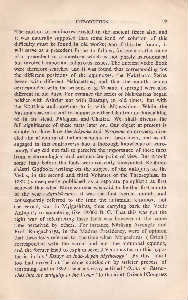Page 656 - Lokmanya Tilak Samagra (khand 2)
P. 656
INTRODUCTION 9
The motion of equinoxes existed in the ancient times also, and
it was naturally supposed that some kind of solution of this
difficulty must be found in old works; and if this be found, it
will serve as a precedent for us to follow, for great is the value
of a precedent in a question which is not purely astronomical
but involved important religious issues. The ancient Vedic Book
were therefore searched and it was found that corresponding tos
the different positions of the equinoxes, the Nak~hatra Series
began with different Nak~hatras; and that the months which
corresponded with the seasons e. g. Vasanta ( spring) were also
different in old days. For instance the series of Naktthatras began
neither with Ashvini nor with Bhara~i, in old times, but with
the K!ittikas and previous to it with Mtjgashiras. While the
Vasanta season is said to comprise either Chaitra and Vaishakha,
or in its stead, Phalguna and Chaitra. We shall discuss the
full significance of these facts later on. Our object at present is
simply to show how the Sayana and Nirayana controversy dire-
cted the attention of Indian scholars to these facts; and as all
engaged in this controversy had a thorough knowledge of astro-
nomy, they did not fail to perceive the importance of these facts
from a chronological and antiquarian point of view. But it took
some time before the facts were correctly interpreted. Kritthl}.a-
shastri Go~bole, writing on the subject of the antiquity of the
Vedas, in the second and third Volumes of the Theosophist, in
1882 ( subsequently published as a separate pamphlet) at first
believed that when Margashirsha was said to be the first month
of the year-Agrahayani- it was the first vernal month and
consequently referred to the time the autumnal equinox, not
the vernal, was in M:rigashiras, thus carrying back the Vedic
Antiquity to something like 19,000 B. C. That this was not the
right way of interpreting these facts was however at the same
time perceived by others. For instance Naraya~ Aiyengar and
Prof. Rangacharya, in the Madras Presidency, were of opinion
that these texts referred to the time when Mrigashiras ( Orion)
corresponded with the vernal and not the autumnal equinox,
and the former tried to explain several Vedic myths on this hypo-
thesis, in his 'Essays on Indo-Aryan Mythology'. By this time I
too had arrived at the same conclusion by stricter process of
reasoning, and in 1892 I sent my essay entitled ' Orion or Resear-
ches into the antiquity of the Vedas ' to the ninth Oriental Congress

